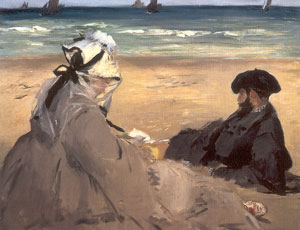Musings
an Online Journal of Sorts
By Alyce Wilson
June 2, 2004 - Impressions of the Sea
On Saturday this past weekend, The Gryphon and I saw a special exhibition at the Philadelphia Museum of Art, Manet and the Sea.
This was the absolutely last weekend we could have seen it. The exhibition had been there for several months, but originally we'd been planning see it with my mom, who was supposed to visit in late April. When she couldn't visit, other activities got in the way.
But as soon as I realized this was the first weekend to see it, I made sure to get us tickets so we could go.
Compared to other exhibitions I've seen at the art museum, this one seemed not to be as big, but it might be that it simply wasn't as crowded, so we got through it more quickly.
They held it in the same exhibition space where last year they held Degas and the Dance. But they had done something entirely different with the space. They constructed temporary columns, painted a grayish blue, and on those hung all the Manet works. Then, on the walls around the exhibit were works by artists who had either influenced him (Gustave Courbet), were contemporaries (Auguste Renoir), or were influenced by him (Claude Monet, Berthe Morisot).
This was one of the more interesting aspects of the exhibit. For example, seeing how young Claude Monet was influenced by Edouard Manet's work. A clear example was two paintings, hung directly opposite each other, that each had done of a Dutch seaside.
Now Manet, of course, is better known for his work with the human figure. Most of his best known paintings involve a very prominently placed figure, who is clearly the main subject of the painting. In contrast, most of these paintings featured the sea alone. Often, the humans were either small or unfinished, clearly not as important to the work.
There were several exceptions, like the well known painting of his wife and brother relaxing on a beach, a painting which in its loose, impromptu strokes seems more like a sketch and which, we are told, one can still see sand from the beach where he painted it.
Then, near the close of the exhibition was an unfinished painting of a radical French journalist, Rochefort, who was escaping from exile in a rowboat. This painting was controversial due to the nature of the subject. But Manet was so intrigued with the subject he did two paintings based on it.


In an unusual experiment, he combined figures from a sketchbook on a small watercolor of a beach scene. But it was obvious these different groups did not fit together.
Manet, of course, like the other Impressionists, believed in showing color in a more vivid, yet realistic way. So for example, in a painting of the ocean the water wouldn't just be blue with white foam. It could be blue with bits of gray or green or purple, depending on the way the light had hit the water at the moment it was painted.
So one interesting aspect of the exhibition was that, depending on which body of water he was painting, the colors might be very different. For example, a scene along the Mediterranean might have more blue-green, whereas a Dutch shoreline, more brown.

Overall, it was an enlightening exhibition and probably also was the best time to see it, although I ordinarily wouldn't wait until the last minute.
Afterwards, I stopped in the gift store and got a souvenir shirt for the exhibition. We also got a couple presents for various couples who are getting married this summer. It's hard to beat the unusual yet artsy gifts at the museum shop.
Then The Gryphon and I looked through the armor exhibit, where he impressed me with his knowledge of ancient armaments. Afterwards, we stopped at the temporary cafe they'd set up on the balcony level and shared a container of grapes and cheese with imported orange soda.
Other thoughts on the Philadelphia Museum of Art:
January 14, 2003 - Museum Hijinks
Moral:
Artwork of the ever-changing sea may well be eternal.
Copyright
2004 by Alyce Wilson
What
do you think? Share your thoughts
at Alyce's message board (left button):
![]()
![]()


